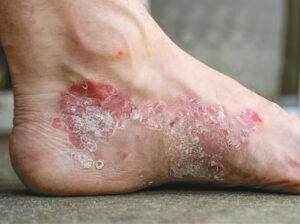By Dr. Lori DeBlasi, DPM, FACFAS
 Psoriasis is a skin condition that makes skin cells turn over faster than normal. Because of the increased cell death, the dead cells buildup on the surface and form red and dry patches of skin topped with silvery scales. These plaques can occur on the elbows, knees, and bottoms of the feet. Psoriasis can also affect the nails and joints. Psoriasis is an autoimmune disease and can also be more severe in people with a weakened immune system.
Psoriasis is a skin condition that makes skin cells turn over faster than normal. Because of the increased cell death, the dead cells buildup on the surface and form red and dry patches of skin topped with silvery scales. These plaques can occur on the elbows, knees, and bottoms of the feet. Psoriasis can also affect the nails and joints. Psoriasis is an autoimmune disease and can also be more severe in people with a weakened immune system.
Foot problems that can be caused by psoriasis include:
Skin changes
Most commonly, psoriasis on the foot looks similar to plaque psoriasis in other locations on the body. The plaques are thick and scaly skin areas that can be painful and bleed if cracks appear. They can also be red and itchy.
Psoriasis can mimic severe athlete’s foot or contact dermatitis. A podiatrist can help determine the cause of the reddened and itchy feet. Treatment of these conditions may differ.
Another skin variant, occurring in 5% of patients with psoriasis, causes pustules to appear on the palms and soles. They look like yellow or white blisters measuring 2-3mm in diameter. These are not infectious, although they may look like they are. The fluid inside of them is sterile and contains no bacteria. Antibiotics will not affect them. The pustules can be painful due to the fluid buildup. They are seen more in women than men. About 10-25% of people with this type of psoriasis have a family history.
Nail changes
Nail psoriasis is quite common, however, not everyone with psoriasis will have their nails involved. The nails that are affected with psoriasis may look like they are lifting off from the nailbed. They also may have small indentations in the surface called pitting. Psoriatic nail changes sometimes will look like nail fungus. The thickening, ridging, pitting, lifting and discoloration of the nail comes from abnormalities in the growth of the tissue within the nail bed and not the surface of the nail. If nails are involved, keeping them trimmed does help to visually make them look better.
Joint changes
Approximately 30% of people that have psoriasis will develop psoriatic arthritis. This is a chronic inflammatory disease of the joints as well as places where tendons and ligaments connect to the bone. Typically, people with psoriatic arthritis will develop psoriasis first and then later the arthritis develops in the joints. The main signs of psoriatic arthritis are like any other type of arthritis including joint pain, stiffness, and swelling. In the feet, psoriatic arthritis typically will affect smaller toe joints rather than larger joints. Sometimes, the toes will get swollen and painful which gives it a sausage-like appearance resulting in “sausage toes”. When this occurs, the smaller joints in the toe and the surrounding tendons become inflamed, resulting in the swollen appearance of the toes. The arthritis flares from psoriasis can alternate with periods of remission and no pain. However, the swelling of thee toes will often persist. The shoes worn must accommodate for the swollen toes. Shoe gear must have a high and wide toe box so the toes do not become further irritated.
Psoriatic arthritis can also affect areas where the tendons and ligaments attached to the bones. In the feet, this can present as Achilles tendinitis or plantar fasciitis. In these cases, the underlying cause is psoriatic arthritis.
Treatment
Both psoriatic arthritis and psoriasis are chronic diseases that worsen over time. A podiatrist is part of the care team, including a primary care physician, dermatologist, and a rheumatologist, in treating psoriasis. Treatment depends on the severity of the disease.
Mild cases of psoriasis may be treated with topical steroid creams. More severe cases of psoriasis may need more advanced treatment with medications that help diminish inflammation and others that depress the immune system.
Currently, there is no cure for psoriatic arthritis. Treatment is aimed at controlling symptoms and trying to prevent further joint damage. Occasionally, a cortisone injection can be performed if symptoms are isolated to a single joint.
Lifestyle changes are also beneficial, including losing weight and remaining physically active. It is best to choose activities that are less stressful on the joints in your feet, such as elliptical machine exercises, stationary biking, swimming and water aerobics. It is also recommended to stretch regularly, ice after exercise and wear supportive shoes at all times.
Prevention
Psoriasis cannot be prevented. With all types of psoriasis, infection and stress are suspected trigger factors. Some patients will identify their own triggers that will make it worse. Additional stress can make psoriasis worse. Stress management techniques may help. For other people avoiding alcohol, dry air or too much/too little sunlight. If identified, avoiding these triggers may help diminish symptoms.
The most important action is to seek medical advice and help when you notice any changes in your feet.
Disclaimer: This content is not intended to be a substitute for professional medical advice, diagnosis, or treatment. Always seek the advice of your physician or other qualified health care provider with any questions you may have regarding a medical condition.
Dr. Lori DeBlasi is certified by the American Board of Foot and Ankle Surgery®. Dr. DeBlasi works at Family Foot & Leg Center at the Estero office. She is accepting new patients.
To make an appointment, call 239-430-3668 or visit www.NaplesPodiatrist.com.
21401 Corkscrew Village Lane,
Suite 4
Estero, FL 33928
(239) 430 – 3668 (FOOT)
www.NaplesPodiatrist.com







